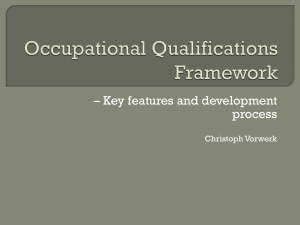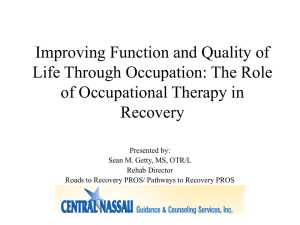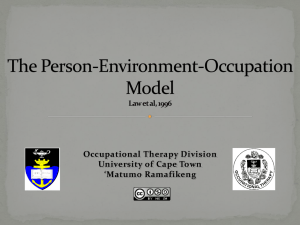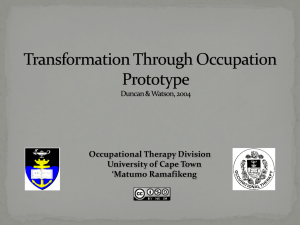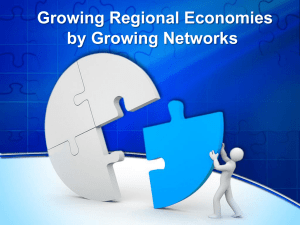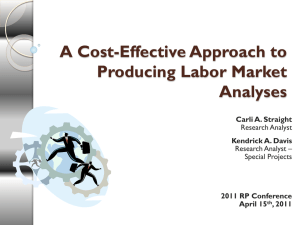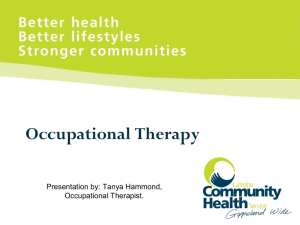Theory of Occupational Adaptation - Vula
advertisement
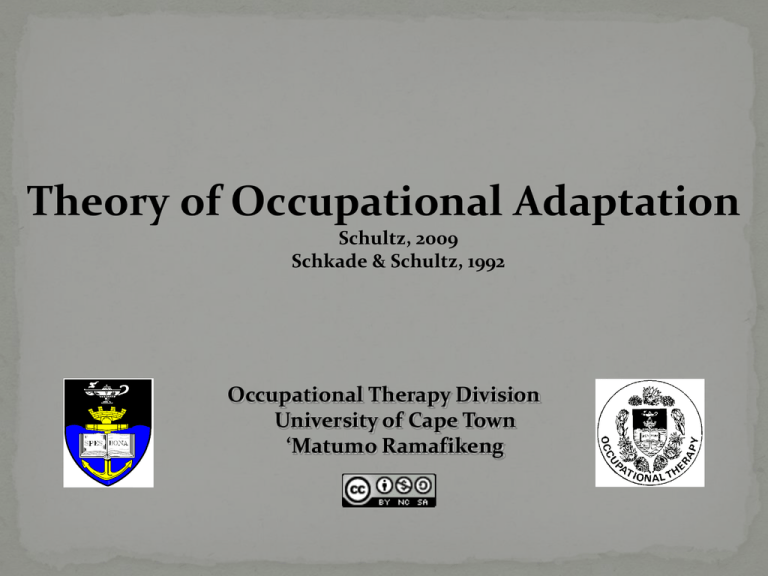
Theory of Occupational Adaptation Schultz, 2009 Schkade & Schultz, 1992 Occupational Therapy Division University of Cape Town ‘Matumo Ramafikeng Integrates original constructs of occupational therapy: occupation and adaptation into a single interactive construct Originally a frame of reference, but further developed into a theory Distinction between other interventions is the focus on improving adaptiveness versus functional skills Similarities to models such as spatiotemporal adaptation, model of adaptation through occupation, MOHO, the model of occupation. Competence in occupation is a lifelong process of adaptation to demands to perform Demands to perform occur naturally as part of person- occupational environment interactions When demand for performance exceeds person’s ability to adapt, dysfunction occurs Adaptive capacity can be overwhelmed by disability, impairment and stress The greater the level of dysfunction, the greater the demand for change in adaptive process Sufficient mastery + ability to adapt= success in occupational performance NB: These assumptions are about the relationship between occupational performance and human adaptation Characterized by constant desire, demand and press for mastery within an occupational environment Dynamic, self-organizing, complex and highly interactive process, despite linear representation Main objective is to achieve mastery over environment Describes interaction between three elements: the person, environment and their interaction Each element is in a fluid and dynamic A change in one element influences other elements Through occupational adaptation people achieve mastery over their health and well-being Person: Represented by the left side of the diagram Relates to the internal factors that affect the person Constant factor is desire for mastery Person is made up of systems: sensorimotor, psychosocial & cognitive that are unique to the individual All occupations involve all the systems The contribution of each system shifts, depending on the occupational circumstances Person: Creates an internal adaptive response to an occupational challenge An observable outcome of the adaptive response is called the occupational response Mastery over environment is an innate human condition Occupational Environment: Represented on the left side of diagram Constant factor is demand for mastery Encompasses external factors that affect the person Dynamic and experiential context within which the person engages in occupations & occupational roles Types of occupational environment are: self-care, leisure/play and work Each type of environment is influenced by social, cultural and physical factors that are part of the person’s experiential context Interaction: Represented in the middle of the diagram Constant factor is press for mastery Interaction between desire for mastery and demand for mastery= press for mastery, creating an occupational challenge Internal & external factors continuously interact through occupation Actions & behaviour carried out in response to an occupational challenge Made up of three subprocesses that are internal to the person: a) Generation subprocess b) Evaluation subprocess c) Integration subprocess Through the subprocesses one plans the adaptation response, evaluates outcome and integrates evaluation as adaptation Anticipatory part of human adaptation consisting of two stages Stage one is activated by adaptive response mechanisms that consists of: a) adaptation energy- primary & high level of cognitive awareness b) adaptive response mode- strategies & patterns established through life experience. They can be new, existing or modified c) adaptive response behaviour may be hyperstable, hypermobile or transitional Stage two: a) Person prepares to carry out planned action by configuring body systems b) Body systems: sensorimotor, cognitive and psychosocial c) Characterized by an adaptation gestalt d) Adaptive response mechanism (stage 1)+ adaptation gestalt (stage 2)= internal adaptive response Personal assessment of the quality of occupational response- relative mastery Relative mastery comprises of efficiency, effectiveness, satisfaction to self and others. When personal assessment yields positive results, there is little need for further adaptation If assessment yields negative results, the integration subprocess relays the information back to the person Engaged when there is need for further adaptation When demand for performance exceeds person’s ability to adapt, dysfunction occurs Continuous inability to generate an appropriate occupational response to an occupational challenge could result in dysfunction The more adaptive the person, the more functional he/she is in daily activities Main goal- client’s ability to adapt is used to maximize effectiveness to adapt Client is assisted in choosing occupational roles and these guide treatment Using occupational readiness and occupational activity OT focuses on clients ability to adapt by directing intervention towards the three subprocesses Treatment needs to progress quickly to meaningful activities Therapeutic use of occupation as a tool to promote adaptive capacity of clients To improve adaptiveness, intervention is focused on improving and activating client’s internal adaptive response OT manages the occupational environment to promote the client’s ability to adapt Client is agent of own change. Schultz, 2009. Theory of Occupational Adaptation. In Crepeau, E.B, Cohn, E.S. & Schell. B.A. 2009. Willard’s & Spackman’s Occupational Therapy. 11th Edition. Philadelphia: Lippincott Williams & Wilkins [Online] Theory of Occupational Adaptation - Overview by Dr Sally Schultz Schkade, J. & Schultz, S. 1992. Occupational Adaptation: Toward a Holistic Approach for Contemporary Practice, Part 1. American Journal Of Occupational Therapy. 46 (9) p29 -p37 This work is licensed under the Creative Commons Attribution-Non CommercialShare Alike 2.5 South Africa License. To view a copy of this license, visit http://creativecommons.org/licenses/bysa/2.5/za/

